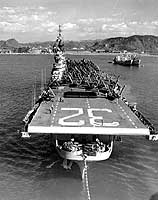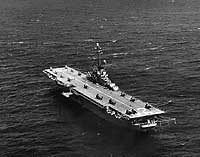
Throughout the very large program to build Essex class aircraft carriers, modifications were constantly made. The number of 40mm and 20mm anti-aircraft machine guns was greatly increased, new and improved radars were added, the original hangar deck catapult installation was deleted, the ventillation system was massively revised, details of protection were altered and hundreds of other large and small changes were executed. In fact, to the skilled observer, no two ships of the class looked exactly the same.
Beginning in March 1943, one visually very significant change was authorized for ships then in the early stages of construction. This involved reshaping the bow into a rather elegant "clipper" form to provide deck space for two 40mm quadruple gun mountings, thus greatly improving forward air defences. Thirteen ships were completed to this "long-hull", or Ticonderoga, class. Four of these were finished in 1944, in time to join their Essex class near-sisters in Pacific combat operations. The rest went into commission between early 1945 and late 1946.Five of the Ticonderoga class were laid up in 1946-47, along with all of the Essexes. Eight stayed on active duty to form, with the three much larger Midways, the backbone of the post-war Navy's combat strength. Though the Truman Administration's defense economies sent three of the active Ticonderogas into "mothballs" in 1949, these soon came back into commission after the Korean War began. Ultimately, all thirteen had active Cold War service. Five of them were thoroughly rebuilt in the early 1950s under the SCB-27 program, and four of these were further modernized a few years later to the SCB-125 design. Another got a combined SCB-27 and SCB-125 redo, while yet another was given a modest reworking to test the revolutionary "angled deck" landing area.
Of the six unmodernized Ticonderogas, three decommissioned in the late '50s and early '60s and were promptly reclassified as aircraft transports (AVT), reflecting their very limited ability to safely operate modern aircraft. The other three, converted to amphibious assault ships (LPH), were active until about 1970. The two least modernized units went into reserve in the mid-1960s, and the rest passed out of the active fleet between 1969 and 1976. All were scrapped, most in the 1970s, although Shangri La survived until the late 1980s.
The Ticonderoga class numbered thirteen completed ships. Another (CV-34) was finished after heavy modifications, two more (CVs 35 and 46) were scrapped incomplete and six Fiscal Year 1945 ships were cancelled before being laid down. Construction of all twenty-two was assigned to six east coast shipyards:
Ticonderoga class "as-built" design characteristics were identical to those of the Essex class except that overall length was 888 feet.
This page features limited pictorial coverage of Ticonderoga class aircraft carriers, as built, with links to pages concerning related classes, modified versions and individual ships.
For views of the closely-related Essex class
and the various later modifications of the design, see:
For coverage of other classes of U.S. Navy fleet aircraft carriers, see: Fleet Aircraft Carriers -- Overview and Special Image Selection.
| If you want higher resolution reproductions than the digital images presented here, see: "How to Obtain Photographic Reproductions." |
Click on the small photograph to prompt a larger view of the same image.
|
Photo #: NH 89281 USS Hancock (CV-19) Underway on 15 December 1944, during operations in the Philippines area. Official U.S. Navy Photograph, from the collections of the Naval Historical Center. Online Image: 153KB; 740 x 640 pixels |
 |
|
Photo #: NH 92243 USS Ticonderoga (CV-14) At sea off the Philippines, just prior to her first strike against the Japanese, 5 November 1944. The ship is painted in camouflage Measure 33, Design 10a. Official U.S. Navy Photograph, from the collections of the Naval Historical Center. Online Image: 90KB; 740 x 605 pixels |
 |
|
Photo #: NH 96051 USS Shangri-La (CV-38) Comes alongside USS Attu (CVE-102) to transfer personnel and supplies, 3 September 1945. Attu's cruise book claims that this was the first side-by-side underway replenishment by two aircraft carriers. Collection of Captain Hays R. Browning, USNR. U.S. Naval Historical Center Photograph. Online Image: 87KB; 740 x 605 pixels |
 |
|
Photo #: 80-G-706709 USS Philippine Sea (CV-47) Exercising at sea with another carrier and a heavy cruiser, circa 1948. The photograph was received by the Naval Photographic Center on 10 January 1949. Note: "E" painted on her stack, location of hull number below the after end of her island; and HO3S helicopter on her flight deck. Official U.S. Navy Photograph, now in the collections of the National Archives. Online Image: 91KB; 740 x 615 pixels Reproductions of this image may also be available through the National Archives photographic reproduction system. |
 |
|
Photo #: 80-G-434496 USS Leyte (CV-32) At anchor in Sasebo harbor, Japan, in November 1950, during a break in her Korean War combat operations. Photographed by AFC O.H. Wilson. Official U.S. Navy Photograph, now in the collections of the National Archives. Online Image: 124KB; 585 x 765 pixels Reproductions of this image may also be available through the National Archives photographic reproduction system. |
 |
|
Photo #: NH 97281 USS Boxer (CV-21) Four F9F-2 "Panther" jet fighters roar past the carrier, with dive brakes, landing gear and arresting hooks down, preparing to land on board after returning from a mission over North Korea, 23 June 1951. The planes and their pilots are from Fighter Squadron 721 (VF-721), a Naval Reserve squadron formerly based at Naval Air Station, Glenview, Illinois. Official U.S. Navy Photograph, from the collections of the Naval Historical Center. Online Image: 99KB; 740 x 610 pixels |
 |
|
Photo #: 80-G-434525 USS Antietam (CV-36) Underway off the east coast of Korea, while operating with Task Force 77. She has Air Group 15 embarked. Photo is dated 16 October 1951, soon after Antietam's arrival in the Korean War zone. Official U.S. Navy Photograph, now in the collections of the National Archives. Online Image: 157KB; 740 x 605 pixels Reproductions of this image may also be available through the National Archives photographic reproduction system. |
 |
|
Photo #: 80-G-K-18429 (Color) USS Philippine Sea (CVA-47) Makes a sharp turn to starboard, while steaming in the Western Pacific with the Seventh Fleet, 9 July 1955. Photographed by PH1 D.L. Lash. Official U.S. Navy Photograph, now in the collections of the National Archives. Online Image: 107KB; 740 x 610 pixels Reproductions of this image may also be available through the National Archives photographic reproduction system. |
 |
|
Photo #: 80-G-K-18427 (Color) USS Philippine Sea (CVA-47) Operating in the Western Pacific with the Seventh Fleet, 9 July 1955. Official U.S. Navy Photograph, now in the collections of the National Archives. Online Image: 107KB; 590 x 765 pixels Reproductions of this image may also be available through the National Archives photographic reproduction system. |
 |
|
Photo #: NH 97313 USS Princeton (CVS-37) Photographed circa the mid-1950s, with twelve S2F anti-submarine aircraft parked forward. Official U.S. Navy Photograph, from the collections of the Naval Historical Center. Online Image: 147KB; 600 x 765 pixels |
 |
|
Photo #: NH 97298 USS Leyte (CVS-32) Off Vieques Island, Puerto Rico, while embarking Marines prior to the "invasion" of the Panama Canal Zone, during amphibious exercises in 1957. She has thirteen HRS and two HUS helicopters of Marine Air Group 26 on her flight deck. Photo was released by the Department of Defense on 2 July 1957. Official U.S. Navy Photograph, from the collections of the Naval Historical Center. Online Image: 123KB; 740 x 605 pixels |
 |
For more views of Ticonderoga class aircraft carriers,
see:
For views of the closely-related Essex class
and the various later modifications of the design, see:
For coverage of other classes of U.S. Navy fleet aircraft carriers, see: Fleet Aircraft Carriers -- Overview and Special Image Selection.
| If you want higher resolution reproductions than the digital images presented here, see: "How to Obtain Photographic Reproductions." |
Page made 8 October 2001